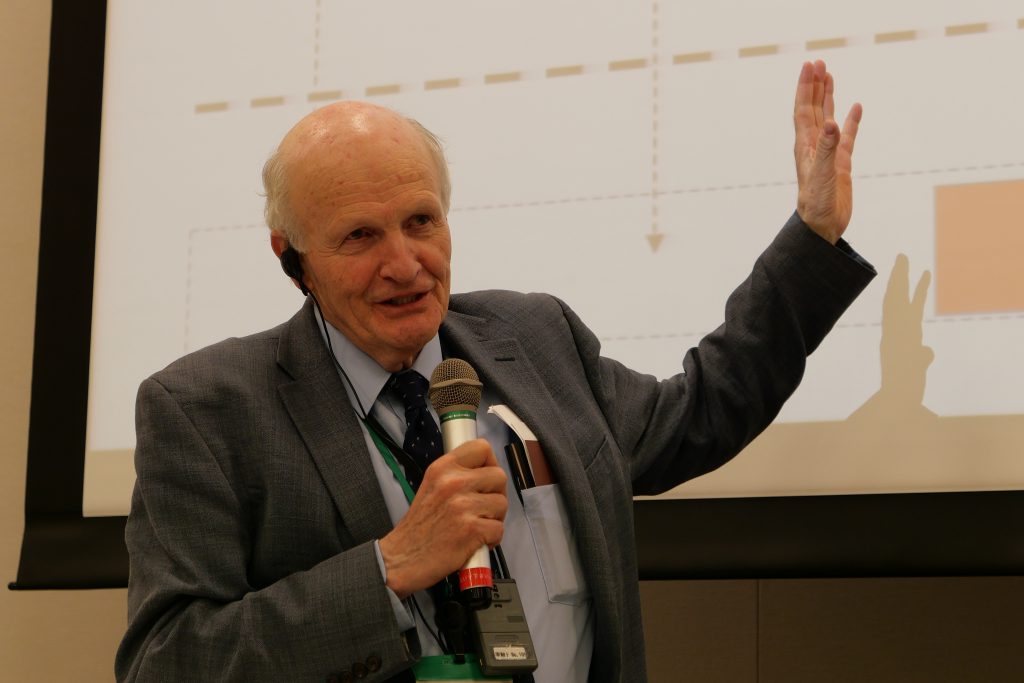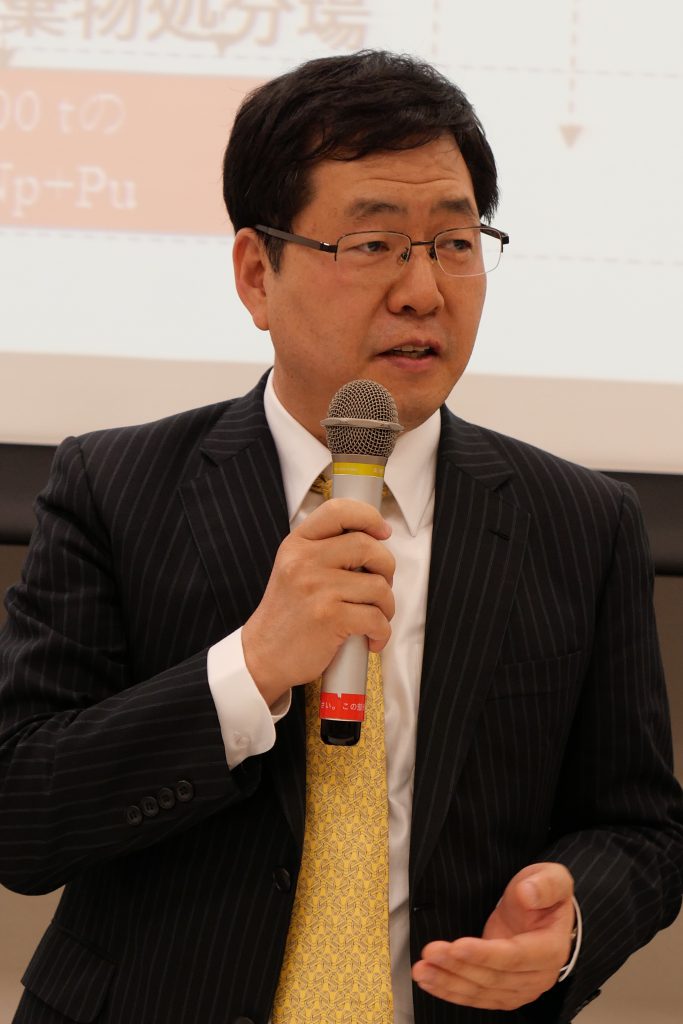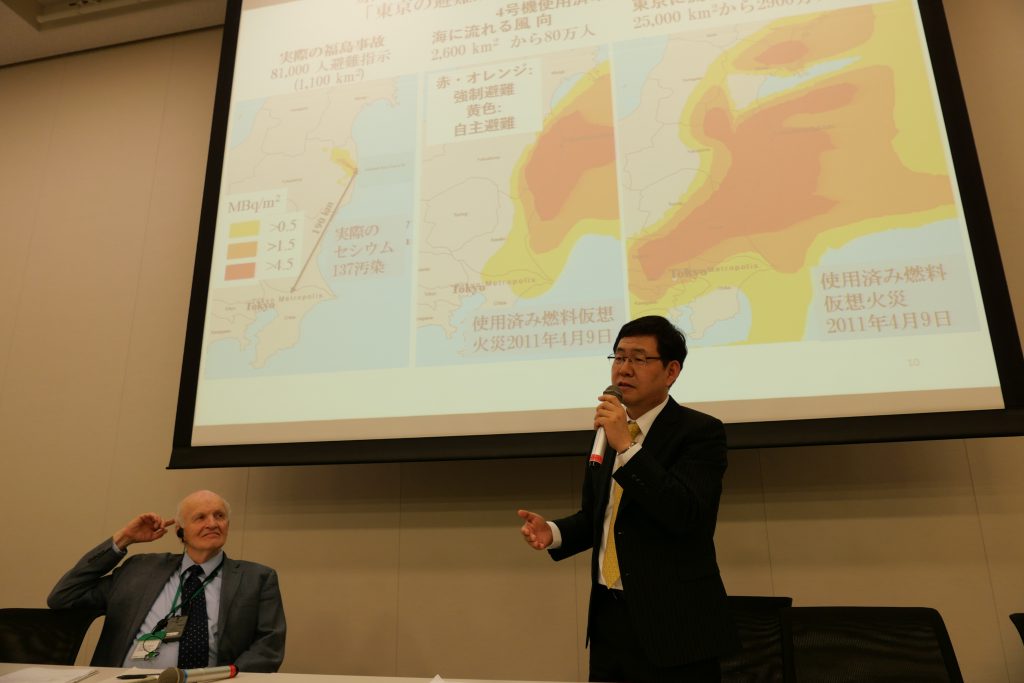The Rokkasho Reprocessing Plant and Nuclear Weapons ~ Efficient use of resources and waste reduction?
CNIC Symposium Report
By Caitlin Stronell
On June 4 CNIC held a symposium at the Diet Members Building in Tokyo. The three speakers, Frank von Hippel, a research physicist and emeritus professor with the Program on Science and Global Security at Princeton University; Dr. Kang Jungmin, an independent nuclear analyst who was the Chair of the Korean Nuclear Safety and Security Commission in 2018; and CNIC’s Matsukubo Hajime each gave detailed talks on the costs and dangers of reprocessing spent nuclear fuel (SNF). All three speakers concluded that the Rokkasho Reprocessing Plant would not accomplish its supposed goals of efficient use of resources and waste reduction, and should not operate.

The symposium was attended by about 90 people, including one Diet Member and several media representatives. Several students of nuclear engineering, as well as their teacher, participated, stimulating lively discussion. It is not often that we get to exchange opinions with people from such a variety of different views and backgrounds, so this was a valuable experience for all.
Session 1: Facts and deceptions ~ analyzing the reprocessing lobby’s claims

The first session addressed the claims of the reprocessing lobby, that reprocessing reduces the hazard and volume of radioactive waste. Reprocessing separates the plutonium from spent fuel and the plan is to then mix it with uranium to create mixed-oxide (MOX) fuel so it can be ‘reused.’ Prof. von Hippel showed that this does not reduce the amount of space required to store or dispose of waste. He pointed out that the long-term decay heat from spent MOX fuel is 5 times greater than that of low enriched uranium fuel. As a result, the waste casks would require correspondingly larger spacing underground to prevent overheating.
In the case of burying spent fuel waste in a repository, reprocessing proponents argue that plutonium and other transuranic elements dominate the toxicity as well as the radioactive decay heat after 300 years, which provides the rationale for why they should be separated. Prof. von Hippel pointed out, however, that in a beyond-worst-case repository failure situation calculated by Sweden’s repository company, SKB, the surface dose would not be dominated by plutonium. In fact, its contribution would be much lower than Carbon-14 in the first several thousand years or Iodine-129 thereafter because of its low solubility and mobility underground. As he joked, “the buried plutonium is only dangerous if someone digs down hundreds of meters and eats it.” Even though Carbon-14 or Iodine-129 would be more dangerous than plutonium, Japan Nuclear Fuel Ltd (JNFL), the operator of Rokkasho, seems much less worried about them and plans to routinely release both of them into the atmosphere and ocean when Rokkasho operates. Rokkasho also would routinely release into the ocean and atmosphere more than 10 times the amount of tritium in the Fukushima Daiichi contaminated water.
Prof. von Hippel also emphasized that, if there is an accident at a reprocessing plant, it is likely to be much more severe than a nuclear repository failure, with greater releases of radionuclides into the environment. Therefore, despite its huge cost, reprocessing has none of its claimed advantages such as reducing waste volume and toxicity.

Next, Dr. Kang gave us an overview of the situation regarding reprocessing R&D in South Korea (ROK). Although the ROK is not permitted to reprocess its SNF under the terms of its 123 Agreement with the US, as a way to deal with the Korea Atomic Energy Research Institute’s (KAERI) insistence that ROK should have the same “right” to reprocess as Japan, a US-ROK Joint Fuel Cycle Study was set up in 2011. It is a ten-year project, but may be extended after 2021 depending on discussions between the ROK and the US. Although most of the research is being carried out jointly in the US, permission was given for KAERI to carry out limited experiments on the first stage of pyroprocessing at its facilities in Daejeon, but it has been unable to go ahead with these experiments due to strong opposition by the local community.
Basically, KAERI cites similar reasons for the necessity of pyroprocessing as Japan does for reprocessing. It claims that pyroprocessing will reduce the required area of an underground waste repository by “up to 100 times” and that the pyroprocessed waste would “decay to the level of natural uranium in roughly 300 years rather than 300,000 years.” As Prof. von Hippel had already pointed out, these ‘reasons’ are largely untrue and would increase risks much more than reduce them. Dr. Kang pointed out that ‘The reduction of the geological disposal area claimed by KAERI would require leaving Cesium-137 and Strontium-90 on the surface for hundreds of years until 99% decayed as well as the fissioning of plutonium and other transuranic elements by fast-neutron reactors such as Monju, which no country has yet succeeded in deploying despite more than 50 years of costly efforts.
KAERI’s plan therefore includes sodium-cooled fast reactors like Monju. This plan is unlikely to materialize under the present Moon administration, but it has not been completely abandoned. Not only are the same discredited reasons used to justify pyroprocessing, the same failed technology is somehow supposed to succeed in the ROK.
Dr. Kang also stressed that separated plutonium is a direct-use nuclear weapons material. The proliferation risks are significant, especially in light of the sensitive situation regarding North Korea’s nuclear weapons.
Following these two presentations, we had the first question and answer session from the audience. There was one question regarding how it is possible to make a nuclear weapon from reactor-grade plutonium. Prof. von Hippel answered that weapons designers now agreed and many studies have been published which show that new bomb designs can readily use so-called ‘reactor-grade’ plutonium to make effective weapons. This discussion continued into the break time with some more detailed technical discussions but in the end, despite claims to the contrary by some nuclear experts in Japan, the questioners could see that the plutonium, which is separated from spent fuel during reprocessing can indeed be used to make nuclear weapons capable of mass destruction.
Another important question from the audience concerned communication between the pro-nuclear and anti-nuclear camps. The two speakers talked about what they called ‘lies’ of the reprocessing proponents, but a questioner said that this must be a difference in viewpoint and had any effort been made to try to bridge this difference? Dr. Kang said that this was not just a difference in viewpoint or opinion, it was a matter of disagreement about scientific facts. While both speakers agreed that calling the opposite camp ‘liars’ was perhaps not conducive to communication, it was important to point out what the scientific facts are and where the proponents are in fact deceiving people. As Prof. von Hippel quoted: “People are entitled to their own opinion, but you are not entitled to your own facts.”
Session 2: Rokkasho’s second reprocessing plant ~ insufficiencies and contradictions
After a brief break, CNIC’s Matsukubo Hajime presented his simulation of three scenarios in which all Japan’s nuclear power plants that have not been scheduled for decommissioning, including 18 planned MOX-fueled reactors, operate mostly for 40 years and some for 60 years. In all three cases both the volume of spent fuel and the reprocessing fund will be insufficient to maintain the reprocessing program.
Matsukubo began his talk by mentioning an article published by Kyodo News in September last year in which it was claimed that the nuclear fuel cycle was facing collapse because ten utilities had decided not to contribute funds to the construction of a second reprocessing plant at Rokkasho which would reprocess spent MOX fuel. The Minister for Economics, Trade and Industry immediately denied this claim and demanded that Kyodo issue a correction. In fact he made this demand at several subsequent press conferences up until March this year. At the same time, the Minister admits that the construction schedule for the second reprocessing plant has not yet been decided and several issues need to be examined. He also has stated publicly that the government is not considering new construction or replacement of nuclear power plants. The minister maintains that the Reprocessing Fund is sufficient to cover reprocessing of all spent fuel, including MOX fuel. This fund is made up of contributions by utilities, set by the amount of fuel they used the previous year, so the amount in the fund depends on how much fuel utilities use. However, Matsukubo’s simulation shows that, for all three cases he examined, there will be insufficient fuel used to generate the required amount of funds to build the second reprocessing plant. Under these circumstances it would seem very likely, as the Kyodo article suggested, that the nuclear fuel cycle is indeed facing collapse and the Minister’s denials simply don’t add up.
Session 3: The danger of spent fuel pools and alternatives to reprocessing

In the final session, Prof. von Hippel and Dr. Kang gave examples and simulations of the extreme dangers of spent-fuel-pool (SFP) fires. Around the world, many SFPs are densely packed with spent fuel rods, well beyond their original design capacity. Spent fuel builds up because a comprehensive way to deal with it has yet to be decided on. In Japan it is waiting to be reprocessed, but this is a highly risky situation. Prof. von Hippel pointed out that the Fukushima Daiichi accident showed us just how dangerous SFPs can be. The water which cools the spent fuel was evaporating rapidly from the Unit 4 SFP pool because it contained a hot, recently discharged core. It was only because water accidentally leaked into the SFP from the adjoining reactor well that the spent fuel remained covered and didn’t catch on fire. If there had been a fire, massive amounts of Cesium-137 and other radionuclides would have been released directly into the atmosphere and simulations show that if the wind had have been blowing towards Tokyo, it would have been necessary to relocate 29 million people. Dr. Kang’s simulation of releases if there was a fire at the Kori NPP in Korea indicate that up to 21 million people in Korea would have to be relocated and in neighboring Japan, relocations would reach up 27 million people.
Prof. von Hippel suggested that a much safer alternative to densely packed SFPs is dry cask storage and gave examples from Germany and the US as well as Japan. A photo of the dry cask storage at Fukushima Daiichi showed the casks covered in seaweed from the tsunami, but safe. Indeed, keeping the spent fuel in dry cask storage until a geological repository becomes available is a much less costly and safer alternative to reprocessing it too.
Conclusion
The speakers each addressed highly technical issues and showed with scientific facts and detailed simulations the contradictions and deceptions that Japan’s nuclear fuel cycle is currently based on, as well as the huge costs and risks involved. The challenge is to communicate this information to the wider public, which will in the end be paying for reprocessing, both in terms of cost and risk and to forge a dialogue with decision-makers so the necessary policy changes can be made.
